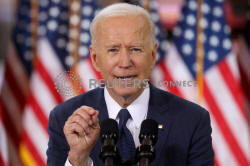Analysis: Can Joe Biden recreate the U.S. economy he grew up with?
 Send a link to a friend
Send a link to a friend
 [April 01, 2021] By
Howard Schneider [April 01, 2021] By
Howard Schneider
WASHINGTON (Reuters) - Joe Biden will
almost certainly be the last U.S. president born as a member of the
"silent generation" demographic group who were children during World War
Two, came of age in an economic boom that built middle class wealth, and
cemented the role of the United States as the world's leading industrial
power.
Over the latter half of his life, Biden, 78, saw the share of national
wealth going to that middle class fall and the gains from U.S. growth
concentrate in a handful of regions. Now, with a roughly $2 trillion
investment package unveiled on Wednesday, Biden wants to reverse that
half century trend and steer capital to neglected people and parts of
the country.
Democrat Biden's jobs and infrastructure plan and the corporate tax
increase to help pay for it, contrasts with the deference to private
markets begun by Republicans with Ronald Reagan's election in 1980, and
nursed through rounds of tax cuts and deregulation, by both parties.
Whether it was Bill Clinton’s moves to reduce social welfare and
deregulate the financial sector, or Barack Obama’s hesitance to "go big"
on spending in the last recession, there has been a reluctance by both
parties to intervene too deeply for decades.

Rural and Rust Belt America faded and there was little progress on
bridging the wealth gaps between Black and white.
Biden's plan harkens to the Democratic leaders of his young adult years
in the 1960s - President John Kennedy’s aspirational focus on public
ventures such as the moon landing, or Lyndon Johnson's Great Society
push to strengthen the social safety net. It also echoes President
Dwight Eisenhower's 1956 act for the government to mostly pay for
building Interstate Highways.
"I am struck by the scale, the structure," MIT economics professor Simon
Johnson said of Biden's plan. "They seem to have taken on board the idea
that you can boost productivity, boost growth, and spread it around the
country," with the right public investments.
EPIC BATTLE LOOMS
The battle over the legislation in the U.S. Congress is expected to be
epic.
Mitch McConnell, the Senate Republican leader, suggested on Wednesday
that any bill Democrats propose may be a "Trojan horse for a massive tax
increase." Republicans have said they won't support Democratic efforts
to inject goals like stopping climate change or equality into a spending
bill.
The proposal follows the more than $5 billion committed over the last
year to fighting the coronavirus, much of it used for direct payments to
families and the unemployed.
The scars from the pandemic may run deep, and the proposed pipeline of
federal dollars into communities, technology research, and job
generating building projects are a way to keep the healing underway,
according to the administration.
Many ideas in the plan have been percolating in universities and other
institutions for years.
Johnson, for example, argued in a 2019 book that private capital will
never fully substitute for government investment in things like new
utility networks or complicated basic research.

The Biden approach is arguably distinct in the breadth of what it wants
to confront in one fell swoop – from deficiencies in child care services
to electric vehicle charging stations – and in its diagnosis of what's
needed.
The demographic and economic decline of small towns and many mid-sized
cities has been underway for decades under Democratic and Republican
presidents even as the rhetoric of both promised to reverse it.
[to top of second column] |

U.S. President Joe Biden speaks about his $2 trillion infrastructure
plan during an event to tout the plan at Carpenters Pittsburgh
Training Center in Pittsburgh, Pennsylvania, U.S., March 31, 2021.
REUTERS/Jonathan Ernst/File Photo

The share of U.S. GDP paid to wages and salaries has declined as well, which
many economists believe contributes to rising inequality.
GRAPHIC: Labor share in decline -
https://graphics.reuters.com/USA-ECONOMY/SPENDING/
ygdpzgorqvw/chart.png
Biden wants to put the public purse behind that promise with both infrastructure
programs and funding for research hubs to try to level the playing field between
middle America and the San Franciscos and Bostons of the world.
Decades ago, the United States used to spend 2% of its GDP on research and
development, Biden noted in a speech on Wednesday. That figure is now less than
1%, even as other countries have increased investment.
"We’ve fallen back," he said. "The rest of the world is closing in and closing
in fast. We can’t less this continue.”
GRAPHIC: U.S. government R&D spending -
https://graphics.reuters.com/USA-ECONOMY/SPENDING/
ygdpzgoqqvw/chart.png
The plan "represents a major effort to tackle the country's widening geographic
inequalities ... It shows an understanding of how infrastructure can create
access and opportunity - or wall it off," said Kenan Fikri, research director of
the bipartisan Economic Innovation Group.
The gap in wealth between Blacks and whites has shown little progress over the
past 30 years, regardless that 16 of them were with Democrats in the White
House.
GRAPHIC: White household wealth vs Black and Latino -
https://graphics.reuters.com/USA-ECONOMY/SPENDING/
qzjpqlzxbvx/chart.png

The Biden proposal aims investment at Black communities, including those
affected by port pollution or other environmental blight, and industries with a
large proportion of Black workers.
AN UNLIKELY RADICAL
Biden, on the surface, is an unlikely figure to push such a radical shift in
federal policy. He first took public office in 1970, the year that U.S. workers'
share of national income peaked. He had a long career working from the very
Democratic center he is now looking to transform, supporting bank-friendly bills
that drew criticism on the campaign trail.
But he became president in a year when the arguments against government
intervention he heard as a senator and as a vice president under Obama seem to
have run their course.
Some of Biden's old colleagues, including Democratic economists such as Lawrence
Summers, say Biden is off base.
In comments on the stimulus plan in February, Summers acknowledged there was
"tremendous suffering" but said "this goes way beyond what is necessary."
Others say it is time to give the more liberal wing of the party, dormant for
decades, time to make their case once again - and are pushing Biden to go even
farther.
"This is not nearly enough," said Alexandria Ocasio-Cortez, Democratic
congresswoman from New York.
(Reporting by Howard Schneider; Editing by Heather Timmons and Grant McCool)
[© 2021 Thomson Reuters. All rights
reserved.] Copyright 2021 Reuters. All rights reserved. This material may not be published,
broadcast, rewritten or redistributed.
Thompson Reuters is solely responsible for this content. |